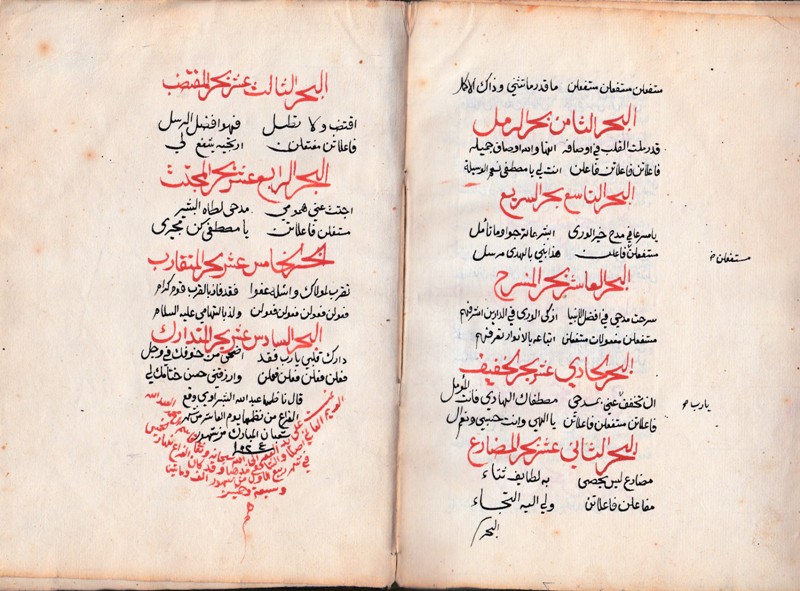Bahr (poetry) on:
[Wikipedia]
[Google]
[Amazon]

 A baḥr (from
A baḥr (from
Rekhta Taqti
that can be used to identify the ''bahr'' of any given ''ghazal'' or ''sher''.
"Poetries in Contact: Arabic, Persian, and Urdu"
In Maria-Kristina Lotman and Mihhail Lotman ed. ''Proceedings of International Conference on Frontiers in Comparative Metrics'', Estonia, pp. 147–173. * Pritchett, Frances W. (1993)
"Orient Pearls Unstrung: The Quest for Unity in the Ghazal"
''Edebiyât'' vol. NS 4, pp. 119–135. * *Thiesen, Finn (1982)
''A Manual of Classical Persian Prosody, with chapters on Urdu, Karakhanidic and Ottoman prosody.''
Wiesbaden. {{DEFAULTSORT:Bahr (poetry) Arabic poetry Persian poetry Azerbaijani poetry Urdu-language poetry Indian poetics Ghazal Poetic rhythm

 A baḥr (from
A baḥr (from Arabic
Arabic (, ' ; , ' or ) is a Semitic languages, Semitic language spoken primarily across the Arab world.Semitic languages: an international handbook / edited by Stefan Weninger; in collaboration with Geoffrey Khan, Michael P. Streck, Janet C ...
, ; fa, بحر; az, bəhr; tr, bahir; ur, بحر; uz, bahr) means a meter in Arabic, Persian, Turkic and Urdu poetry. Essentially, ''bahr'' is a specific pattern, combining the ''arkaan'' of Urdu prosody that define the "length" of a ''sher''. However, generally ''bahr'' is categorized in three classes: Short, medium, long, depending upon the length of the ''sher'' of the ''ghazal''.
For a ''ghazal'', since all the ''shers'' in it should be of the same ''bahr'', determining the ''bahr'' of one ''sher'' (or even one line of the ''sher'') is enough to determine the ''bahr'' of the entire ''ghazal''. For example, in this ''ghazal'' of Ghalib
Mirza Beg Asadullah Khan (Urdu, fa, مرزا بیگ اسد اللہ خان; 27 December 1797 – 15 February 1869) also known as Mirza Ghalib (Urdu, fa}) was an Urdu and Persian language, Persian shayar (poet), poet of the 19th century Mughal Em ...
, the length and meter of the ashaar is same throughout. In terms of the European method of scansion, the metre can be written as follows (where "x" = long or short, "u" = short, "–" = long, "u u" = one long or two short syllables):
:x u – – u – u – u u –
:''koii ummiid bar nahiin aatii''
:''koii suurat nazar nahiin aatii ''
:''aage aatii thii haal-e-dil pe hansii ''
:''ab kisii baat par nahiin aatii ''
:''jaanataa huun savaab-e-taa'at-o-zahad''
:''par tabiiyat idhar nahiin aatii ''
:''hai kuchh aisii hii baat jo chup huun''
:''varna kyaa baat kar nahiin aatii ''
:''kaabaa kis muunh se jaaoge 'Ghaalib
:''sharm tumako magar nahiin aatii''
The ghazal above is written in a bahr called: ''khafiif musaddas makhbuun mahzuuf maqtu'' (Meter G8). This is a ten-syllable bahr and by the standards of Urdu poetry, is a ''chotii'' (small) bahr.
As with the scansion of Persian poetry, a syllable such as ''miid'' or ''baat'' consisting of a long vowel plus consonant, or ''sharm'' consisting of a short vowel and two consonants, is "overlong", and counts as a long syllable + a short one.
In Urdu prosody, unlike Persian, any final long vowel can be shortened as the metre requires, for example, in the word ''kaabaa'' in the last verse above.
Taqti
Taqti is the process of breaking down words of all verses of a ''ghazal'' or a poem into fundamental syllables, calculating their weights (''vazn''), and checking if all verses have a consistent meter. For example, the word ''jaanisaar'' can be broken down into four syllables: ''jaa'', ''ni'', ''saa'' and ''r''. The weight of ''jaa'' is 2, ''ni'' is 1, ''saa'' is 2 and ''r'' is 1, thus making the weight of the word ''jaanisaar'' 2121.Rekhta
''Rekhta'' ( ur, ; hi, रेख़्ता ) was the Hindustani language as its dialectal basis shifted to the Delhi dialect. This style evolved in both the Urdu alphabet, Perso-Arabic and Devanagari scripts and is considered an early for ...
has developed a free online toolRekhta Taqti
that can be used to identify the ''bahr'' of any given ''ghazal'' or ''sher''.
Types of bahr
There exist many bahrs, but mainly there are 19 bahrs used in Urdu poetry. These bahrs are further distributed in different types, but they are not described here. The names are: * baHr-e-rajaz * baHr-e-ramal * baHr-e-baseet * baHr-e-taweel * baHr-e-kaamil * baHr-e-mutadaarik * baHr-e-hazaj * baHr-e-mushaakil * baHr-e-madeed * baHr-e-mutaqaarib * baHr-e-mujtas * baHr-e-muZaara * baHr-e-munsareH * baHr-e-waafer * baHr-e-qareeb * baHr-e-saree * baHr-e-khafeef * baHr-e-jadeed * baHr-e-muqtaZebReferences
Bibliography
*Deo, Ashwini; Kiparsky, Paul (2011)"Poetries in Contact: Arabic, Persian, and Urdu"
In Maria-Kristina Lotman and Mihhail Lotman ed. ''Proceedings of International Conference on Frontiers in Comparative Metrics'', Estonia, pp. 147–173. * Pritchett, Frances W. (1993)
"Orient Pearls Unstrung: The Quest for Unity in the Ghazal"
''Edebiyât'' vol. NS 4, pp. 119–135. * *Thiesen, Finn (1982)
''A Manual of Classical Persian Prosody, with chapters on Urdu, Karakhanidic and Ottoman prosody.''
Wiesbaden. {{DEFAULTSORT:Bahr (poetry) Arabic poetry Persian poetry Azerbaijani poetry Urdu-language poetry Indian poetics Ghazal Poetic rhythm